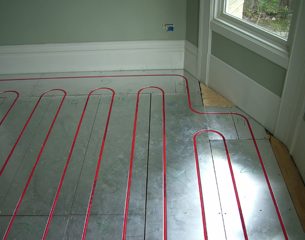Radiant Heat Flooring

Radiant Heat Flooring - In-Floor Heating System
Radiant Heat Flooring is a very comfortable form of central heating that is often used in home designs. Since it uses radiant energy to regulate indoor temperatures, it is commonly referred to as radiant floor heating.
Radiant Heat Flooring - In-Floor Heating Options
Most underfloor heating systems use an electric system or a hydronic system to heat the floor, which then radiates into the room space. Both types can be used as a whole-building system or as a localized heating system for heating individual rooms. In residential homes, a in-floor radiant system is often used to supplement other heating systems to reduce overall energy usage.
Radiant Heat Flooring - Hydronic Radiant Floor Heating Systems
A hydronic in-floor heating system uses water or other liquids like propylene glycol, which is heated and circulated through tubing (made from cross-linked polyethylene, or PEX) embedded in poured concrete flooring. It is a closed-loop system that recirculates the heated liquid from the boiler through the flooring. Hydronic systems require professional due to the complexity involved with boilers, circulators, fluid pressure, and so on.
Radiant Heat Flooring - Electrical Systems
An in-floor electrical heating system uses flexible cables, mats or mesh films, installed in a poured concrete floor, or directly under floor finishes such as hardwood, laminate, or carpet. Electrical systems are typically easier to install for do-it-yourselfers than the hydronic forms of in-floor heating.
Advantages of Radiant Heat Flooring
Most homes use convective forms of heating such as forced-air heating systems. With forced-air, warm air is blown into a room, which allows the warm air to rise, leaving the ceiling warmer than the floor. In a radiant in-floor heating system, there is usually only a 2 to 4 degree variation in the temperature from the floor to the ceiling, a much more uniform temperature throughout the entire room. Studies have shown that homes using radiant in-floor heat can set the thermostat 6 to 8 degrees cooler than a home using forced-air heating. This reduces energy usage.
Another advantage of radiant underfloor heating is that it doesn't require humidification. Forced-air heating systems typically dry the air out as it circulates through ducting and vents, but radiant heat doesn't affect the moisture levels in a home's air. This reduces the need for electrical humidification, further lowering energy use and cost.
Radiant underfloor heating is much quieter than forced-air. There's no fan blowing air throughout the entire house, only warmth radiating silently up through the floor.
Perhaps the biggest advantage of radiant underfloor heating, and the reason most people use it, is that it provides very comfortable heat. Floors aren't cold to the feet in the morning, and the room's temperature is uniform, without drafts sometimes associated with forced-air.
Potential Disadvantages of Radiant Heat Flooring in Green Home Designs
While radiant heat does provide very comfortable heat, and has the potential for lower energy usage, there are some issues that should be addressed before deciding to use it in a very efficient green home design.
Maintenance of radiant in-floor heating systems can be tricky. Since the heating components are often embedded within the flooring in a hydronic system or directly under flooring material in an electrical system, if a part malfunctions or stops working, it is very difficult getting to them to repair or replace them without tearing up all or part of the floor.
Radiant Heat Flooring can be expensive; it can cost upwards of $8,000 to heat even a moderately sized home with underfloor radiant heat.
A radiant floor heating system can be a good choice for an existing home that doesn't have many other energy-saving features in use, but its use in a super-efficient green home may not be the best fit.
A Radiant Heat Flooring system will often produce more heat than a green home can use, which can result in overheating. Radiant heat also takes time before heat is supplied to the floor and begins to radiate heat into the room. If a home incorporates passive solar heating in its' design, the radiant floor heat can cause overheating, as the floor heat can't be turned off when the sun comes out.
A well-designed, well-built green home will require very little energy to heat, making the expense of radiant floor heating hard to justify. Money can be better spent building a super-insulated green home with R-25 walls, R-40 ceilings, triple-glazed, low-e windows, and passive solar design, all working to create a super-tight, efficient home. These features will allow you to spend much less money on a smaller, less-expensive (but still energy-efficient) heating and cooling system.
To learn more about installing in-floor radiant heating, click HERE.
comments powered by Disqus

























































































































































































